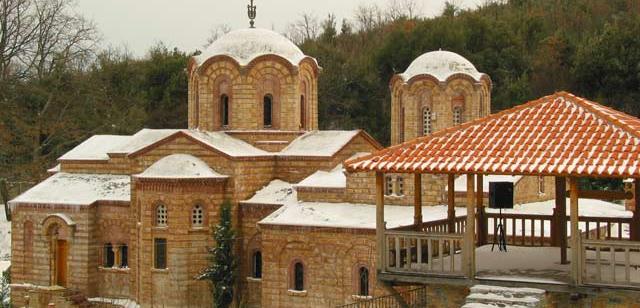
OLD MONASTERY’S HISTORY
The Holy Monastery was founded by its founder as Patriarchal and Stavropegic and was dedicated to the Holy Trinity, following Divine revelation. Later on, the name of its founder predominated. St. Dionysios created a monument of rare architectural and aesthetic beauty, ideally integrated into the natural environment; built as a fortress, from stone and wood, on a natural fortified plateau
ARCHITECTURE OF THE OLD MONASTERY
The main church (Katholiko) is a cruciform Byzantine church of the Athonite type. It is surrounded by four chapels, creating an aesthetically functional ensemble. St. Dionysios΄ grave is located in the northwestern one, while the southwestern one is dedicated to St. Nikanor, a contemporary friend and co-ascetic of St. Dionysios.
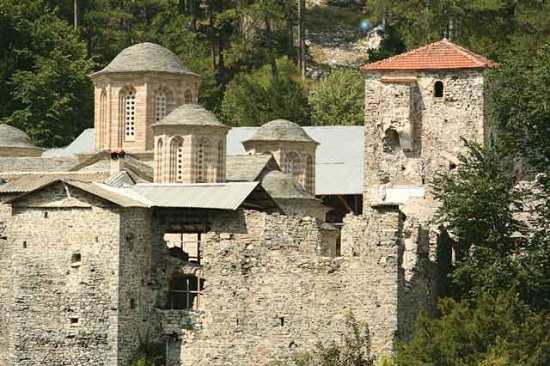
The wings of the Holy Monastery΄s buildings and the watch tower complement its handsome architecture.
At the entrance of the Monastery, on the lintel, there is an extant fresco depicting St. Dionysios. On the ground floor of the northern wing, was housed the dining room and the kitchen, while on the floor, one can find cells and two chapels. On this floor was also housed the library and the abbot΄s quarters. To the northwest, there is still today a drinking fountain.
On the destroyed three-storey western wing, there were monks cells and on the southwestern corner, the bell-tower, with a clock on its upper part. The southern wing has two storeys and a basement. On this wing are preserved cells on the storeys. The cells are vaulted spaces of small dimensions, with low entrance.
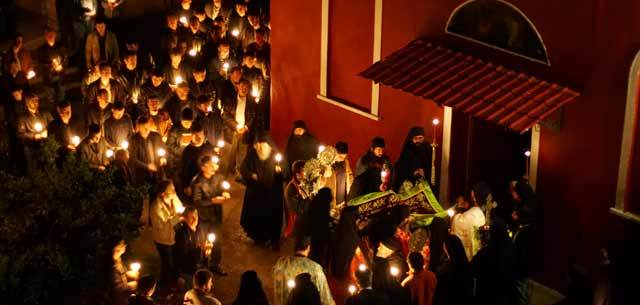
SPIRITUAL ACTIVITY
Thanks to St. Dionysios΄ blessings, despite the numerous destructions, the Monastery has been enjoying continuous life and monks΄ presence for about 500 years. Due to St. Dionysios΄ personality, it soon became widely known and developed great spiritual activity, in line with its founder΄s pattern.
Centuries ago, the reputation of the old Monastery surpassed the boundaries of the Greek territory reaching Tsarist Russia.
Even today, thousands of people, coming from both neighboring and distant areas, come to worship and pray to the Saint.
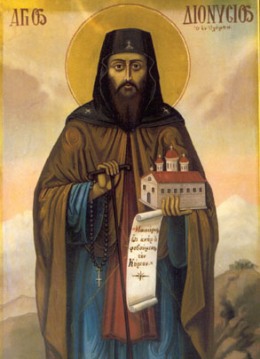
The Monastery of St. Dionysios became integral part of Greece΄s long history, society and education. There was an organized icon painting workshop and manuscript transcription center, thanks to which many old texts have been preserved. The Monastery΄s school was attended by many pupils, including the areas΄ great chieftains, perhaps even Rigas Fereos.
The Monastery however was destined to be afflicted, suffer the price for its contribution to the education of the faithful, to the protection of traditions. In 1821, it was set afire by Veli Pasha, son of Ali Pasha. After a three-day battle, Hegumen Methodios Paliouras was hung along with another 12 monks at the central square of Larissa.
During the Olympus Revolt in 1878, the Monastery took again active part; by providing shelter to the women and children of Litochoro, it disrupted for the first time the entrance prohibition for women. The Metochion of Skala was used as replenishment and disembarkation station for the Greek fighters. During the Macedonian Struggle, it constituted again shelter for the fighters and replenishment station.
Despite all the successive natural or volitional destructions and the ceaseless pillages, the Monastery kept on protecting the inhabitants of Mt. Olympus under its sacred shadow.
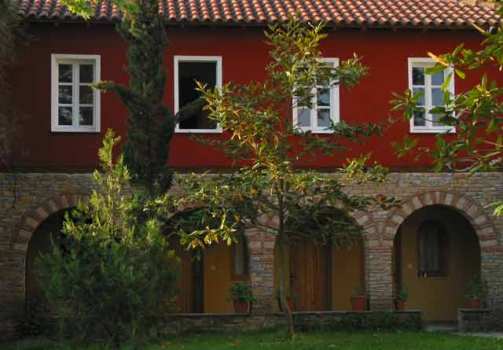
RECONSTRUCTION AND MAINTENANCE
On April 29 (1943), a Thursday of the Easter week, a walking section of Germans climbed up to the Monastery and destroyed it, using explosives.
Today, after decades of desertion, the monks΄ and believers΄love for the Saint embrace the Monastery anew. The main church, the Katholikon, has been restored according to its initial plan.
The main concern of everybody, though, remains the full reconstruction of the wounded monastery; to become the same as it was in the past.
|
NEW MONASTERY’S HISTORY Today, the visitor will find the new Monastery, at a height lower than the initial building, at the location of the old Metochion of Skala, built in 1650, at 3 km from Litohoro and 15 km from the old Monastery.Its main church is dedicated to the Assumption of the Mother of God. Its temple is adorned by the icons, painted in 1955 by the brilliant hagiographer Fotis Kontoglou.From 1989 on was restituted the Monastery΄s entrance prohibition for women, in line with the tradition bequeathed by St. Dionysios. Only men are allowed in the prohibited area. Here are located the monks΄ cells, the workshops, the dining room and the main church, where are celebrated the daily services.In the remaining area, where all believers are allowed, a new spectacular church, dedicated to St. Dionysios, was built, where the Divine Liturgy is celebrated every Sunday. |
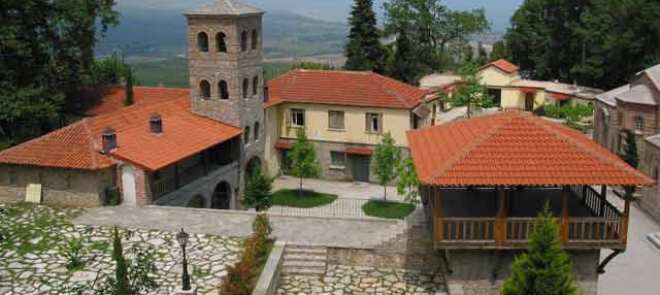
MUSEUM – LIBRARY
Amongst the new buildings of the Metochion of Skala stands out the Monastery΄s Museum, in the recently renovated old Abbot΄s quarters, which was inaugurated in 1999 by the Ecumenical Patriarch Bartholomew.
Its first floor operates today as Library and Study, with many remarkable publications. On the ground floor valuable heirlooms are exhibited. Hidden for three years, in a vault of the old Monastery, they were also preserved thank to the monks΄ provision.
An epitaph of 1579, many holy relics in elaborate silver cases, carven crosses, icons dating back to the 16th century or later, patriarchal sigilliums, a Russian imperial golden bull of 1692, canonicals of the 18th & 19th centuries, twenty manuscripts (1 parchment and 19 paper) and about one hundred inculabulars and printed books from 1574 to 1900 speak eloquently of the Monastery΄s past and brilliant history, for the tireless works of men that prove in the coming centuries the brilliance of the Christian Orthodox art.





